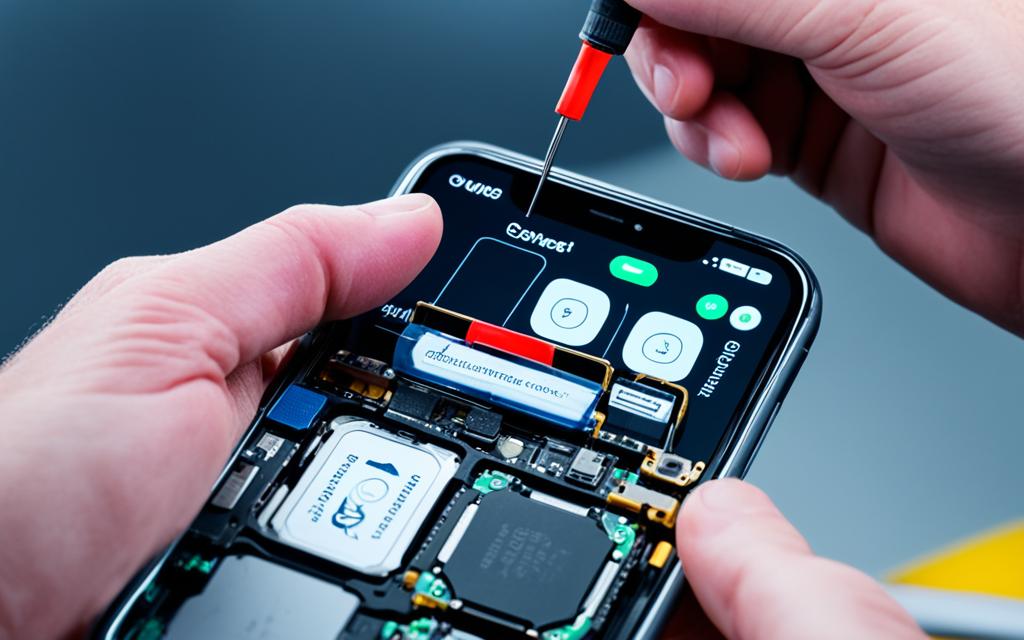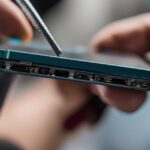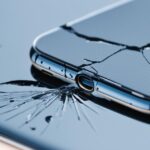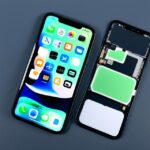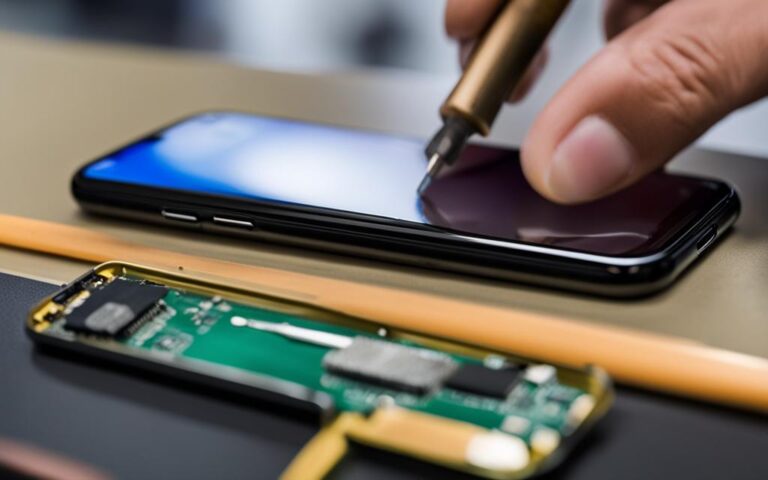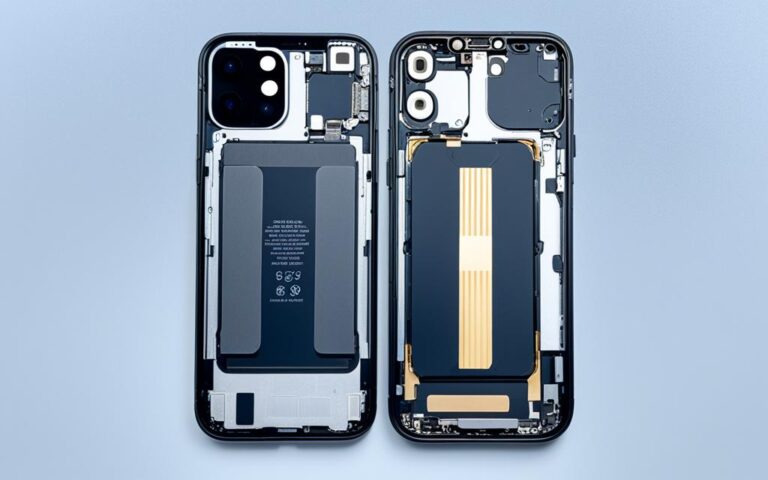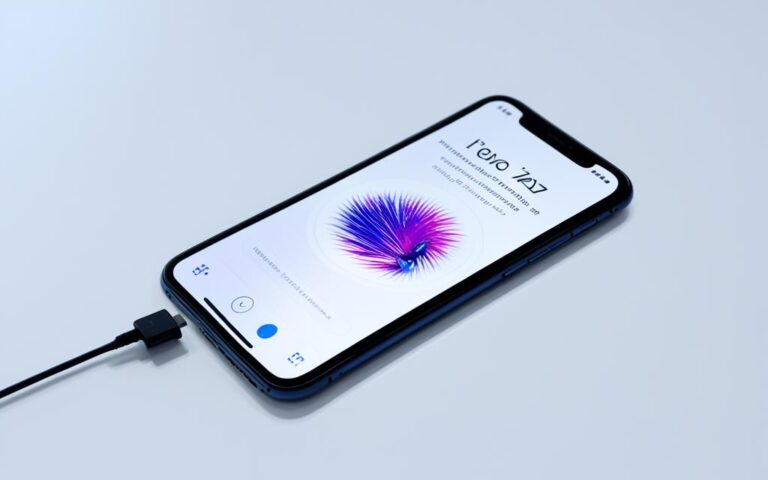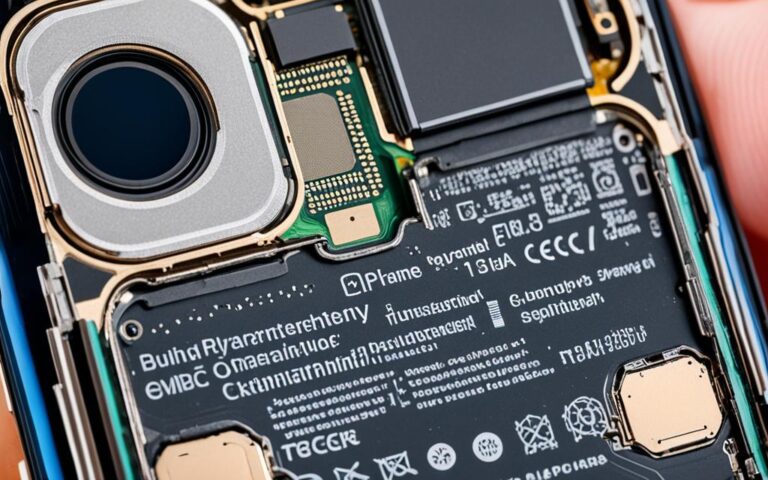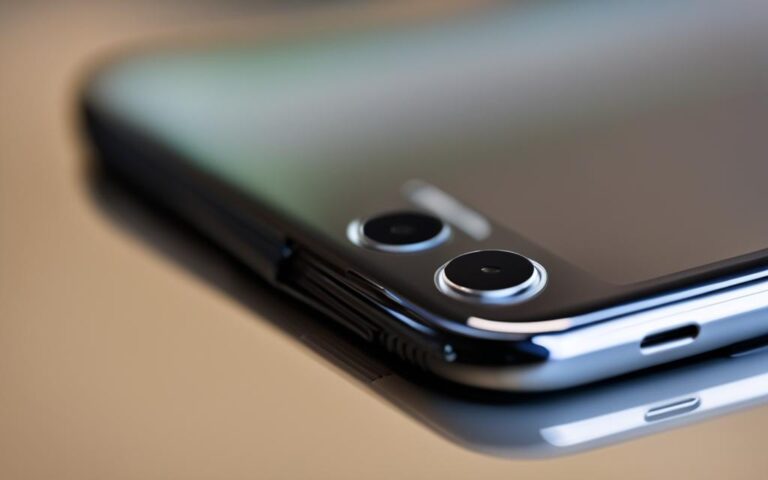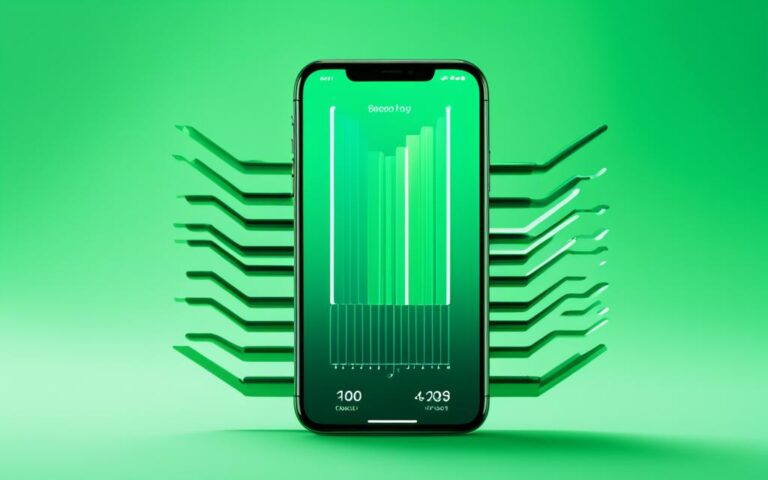iPhone Proximity Sensor Repairs for Screen Functionality
Welcome to our comprehensive guide on iPhone proximity sensor repairs for screen functionality. If you’re experiencing issues with your iPhone’s proximity sensor, you’re in the right place. Our expert repair services are available across the UK, offering reliable solutions to restore your device’s proper functionality.
The proximity sensor is a vital component of iPhones, responsible for detecting objects near the device. When it malfunctions, it can disrupt the user experience, affecting automatic screen dimming during calls and preventing accidental touches.
Whether your proximity sensor is broken due to physical damage, screen replacement, manufacturer problems, or software issues, we have you covered. Our guide will walk you through effective solutions to fix the issue, ensuring your iPhone’s screen functionality is restored.
Stay tuned as we explore various fixes, including system reboots, cleaning the display, performing hard resets, and aligning or changing the proximity sensor. We’ll provide step-by-step instructions tailored to different iPhone models, empowering you to resolve the problem on your own.
Remember, in case the issues persist or if you prefer professional assistance, our experts are here to help. Let’s dive into the world of iPhone proximity sensor repairs and get your device back on track!
What is the iPhone Proximity Sensor?
The iPhone proximity sensor is a valuable feature that enhances user experience by performing various functions. One of its primary functions is automatic screen dimming during calls, which helps conserve battery life and prevent accidental button presses. When the iPhone is held up to the ear during a call, the proximity sensor detects the presence of the user’s face and dims the screen to reduce distractions. This feature ensures that the call remains uninterrupted and that unintentional actions, such as muting the call or activating speakerphone, are avoided.
In addition to automatic screen dimming, the iPhone proximity sensor is also responsible for preventing accidental touches. When the device detects an object close to its proximity, such as when it is placed inside a pocket or purse, it disables the touch functionality of the screen. This prevents unintended actions from occurring, such as launching apps or making accidental calls, and helps to preserve battery life by keeping the screen off when not in use.
“The iPhone proximity sensor plays a crucial role in optimizing user experience by automatically dimming the screen during calls and preventing accidental touches.”
The proximity sensor is a small component located near the front-facing camera of the iPhone. It consists of an infrared emitter and a receiver that work together to detect the presence of objects. When the emitter sends out an infrared signal, it bounces off objects in front of the phone and is picked up by the receiver. By measuring the time it takes for the signal to return, the proximity sensor can determine the distance between the device and the object.
Overall, the iPhone proximity sensor is a critical feature that seamlessly integrates with the device’s functionality. Its ability to automatically dim the screen during calls and prevent accidental touches enhances the user experience and ensures smooth operation.
The Role of the iPhone Proximity Sensor
The iPhone proximity sensor serves two main purposes:
- Automatic Screen Dimming: During calls, the proximity sensor detects the presence of the user’s face and dims the screen to prevent distractions and accidental button presses.
- Preventing Accidental Touches: When the device detects an object near its proximity, the touch functionality of the screen is disabled, avoiding unintended actions and conserving battery life.
| Function | Benefits |
|---|---|
| Automatic Screen Dimming | – Conserves battery life – Reduces distractions during calls |
| Preventing Accidental Touches | – Avoids unintended actions – Preserves battery life |
Why is my iPhone’s Proximity Sensor Broken?
There are several reasons why an iPhone’s proximity sensor may be broken. It could be due to physical damage, such as dropping the phone or changing the screen. Additionally, manufacturer problems or software issues can also cause the proximity sensor to malfunction.
A broken iPhone proximity sensor can be frustrating as it affects the functionality of the device. Whether it’s a result of physical damage or underlying software problems, it’s important to address the issue to restore proper functionality. In some cases, the proximity sensor may need to be replaced.
If the phone has experienced physical damage like being dropped or having the screen replacement, it’s possible that the proximity sensor has been affected. Physical damage can cause misalignment or even damage to the sensor itself, resulting in its malfunction. In these cases, professional assistance may be required to replace the proximity sensor.
Manufacturer problems can also contribute to a broken proximity sensor. Sometimes, there may be manufacturing defects that affect the functionality of the sensor. If this is the case, it’s advisable to contact Apple or an authorized service provider to address the issue.
Software issues can also cause the proximity sensor to malfunction. Updates or software glitches can disrupt the sensor’s functionality, leading to issues with automatic screen dimming or accidental touch prevention. Troubleshooting the software, updating the device, or performing a hard reset may help resolve the problem.
It’s important to note that while there are potential DIY solutions to fix a broken proximity sensor, it’s generally recommended to seek professional help, especially for physical damage or manufacturer-related problems. Professional repair services have the expertise and tools to properly diagnose and fix proximity sensor issues.
Steps to fix a broken iPhone proximity sensor:
- Contact Apple or an authorized service provider if the proximity sensor is affected by physical damage or suspected manufacturing defects.
- Update the device’s software to the latest version to address any software-related issues.
- Perform a hard reset by pressing and holding the power and volume buttons simultaneously until the Apple logo appears.
- Try putting the iPhone in Recovery Mode and restore the device through iTunes if necessary.
- Consider professional screen replacement services that ensure proper alignment of the proximity sensor.
| Possible Causes of a Broken iPhone Proximity Sensor | Solutions |
|---|---|
| Physical damage from dropping the phone or screen replacement | Professional repair or screen replacement |
| Manufacturer problems | Contact Apple or an authorized service provider |
| Software issues | Update software, hard reset, or put the iPhone in Recovery Mode |
By addressing the causes of a broken iPhone proximity sensor and taking appropriate action, you can restore the functionality of your device and enhance your user experience.
How to Fix the iPhone Proximity Sensor Issue?
If you’re experiencing problems with your iPhone’s proximity sensor, there are several solutions you can try to resolve the issue. By following these steps, you can fix the proximity sensor problem and ensure the smooth functionality of your phone. Let’s take a closer look at each solution:
1. Reboot Your Phone
One of the first steps you should take is to reboot your iPhone. This can help resolve minor software glitches that may be affecting the proximity sensor. To reboot your phone, simply press and hold the power button until the “Slide to power off” option appears. Slide the power icon to turn off your phone, then press and hold the power button again to turn it back on.
2. Fix System Errors
If rebooting doesn’t solve the issue, you may need to fix system errors on your iPhone. Connect your device to a computer with iTunes installed, and then select your iPhone from the device list. Click on “Restore iPhone” to reinstall the operating system and fix any potential software errors that may be causing the proximity sensor problem.
3. Clean Your Display
Dirt or smudges on your iPhone’s display can interfere with the proximity sensor’s functionality. Gently clean the screen using a soft, lint-free cloth to remove any fingerprints, dust, or debris. Make sure to avoid using harsh chemicals or abrasive materials that could damage the display.
4. Perform a Hard Reset
If the issue persists, performing a hard reset on your iPhone can help reset various system settings and resolve software conflicts. The method to perform a hard reset varies depending on the iPhone model you have. Please refer to Apple’s official website or user manual for specific instructions on how to perform a hard reset for your device.
5. Put Your iPhone in Recovery Mode
In some cases, putting your iPhone in Recovery Mode can help resolve proximity sensor issues. Connect your iPhone to a computer with iTunes and force restart your device. When the “Connect to iTunes” screen appears, follow the on-screen instructions to enter Recovery Mode. From there, you can choose to update or restore your iPhone’s software, which may fix the proximity sensor problem.
6. Align or Change the Proximity Sensor
If none of the above solutions work, it’s possible that the proximity sensor itself is misaligned or damaged. In this case, it may be necessary to align or change the proximity sensor component. We recommend seeking professional assistance from an authorized Apple service provider or a reputable repair technician to ensure proper alignment or replacement.
By following these troubleshooting steps, you can effectively address iPhone proximity sensor issues and restore the optimal functionality of your device.
Force-Restart your iPhone to Fix Proximity Sensor Issues
If you’re experiencing proximity sensor issues on your iPhone, a simple force-restart might just do the trick. By performing a force-restart, you can reset the system and free up memory, potentially resolving any problems with the proximity sensor.
The process for force-restarting your iPhone may vary depending on the model you have. Below, we’ve provided instructions for some common iPhone models:
Force-Restart iPhone X or later models:
- Press and quickly release the volume up button.
- Press and quickly release the volume down button.
- Press and hold the side button until you see the Apple logo.
Force-Restart iPhone 8 and iPhone 8 Plus:
- Press and quickly release the volume up button.
- Press and quickly release the volume down button.
- Press and hold the side button until you see the Apple logo.
Force-Restart iPhone 7 and iPhone 7 Plus:
- Press and hold both the volume down button and the power button.
- Continue holding both buttons until you see the Apple logo.
By following these steps, you can force-restart your iPhone and potentially resolve any proximity sensor issues you may be experiencing. If the problem persists, it’s recommended to seek professional assistance.
Remember, force-restarting your iPhone should only be done as a troubleshooting step and not as a regular maintenance practice. If you’re unsure or uncomfortable performing a force-restart, it’s always best to consult the official Apple support or visit an authorized service center.
| iPhone Model | Force-Restart Process |
|---|---|
| iPhone X or later | Press and quickly release the volume up button, followed by the volume down button. Finally, press and hold the side button until the Apple logo appears. |
| iPhone 8 and iPhone 8 Plus | Press and quickly release the volume up button, followed by the volume down button. Finally, press and hold the side button until the Apple logo appears. |
| iPhone 7 and iPhone 7 Plus | Press and hold both the volume down button and the power button until the Apple logo appears. |
Clean Your Phone and Phone Case
Physical matter, such as dirt or grime, can obstruct the proximity sensor and cause it to malfunction. To resolve proximity sensor issues, it is essential to clean both your phone and phone case thoroughly. Follow these steps to ensure a clean iPhone and case:
- Remove the phone case: Take off the phone case to access the front of your iPhone.
- Remove the screen cover: If you have a screen protector, carefully peel it off.
- Clean the front of the phone: Use a microfiber cloth slightly dampened with water or a mild cleaning solution to wipe the front of your iPhone. Be gentle and avoid getting moisture into any openings.
- Pay attention to the proximity sensor area: Specifically focus on the area around the proximity sensor, usually located near the earpiece. Make sure there is no dirt, grime, or any other debris that may be blocking the sensor’s functionality.
- Clean the phone case: If your phone case is dirty or dusty, clean it separately using an appropriate cleaning method recommended by the case manufacturer.
- Reassemble your iPhone: Once both the phone and phone case are clean and dry, reattach the phone case and apply a new screen protector if desired.
By maintaining a clean iPhone and phone case, you can minimize the chances of dirt or grime interfering with the proximity sensor’s operation. Taking regular cleaning precautions will help ensure optimal functionality and improve your overall iPhone experience.
| Cleaning Steps | |
|---|---|
| Step 1 | Remove the phone case |
| Step 2 | Remove the screen cover |
| Step 3 | Clean the front of the phone |
| Step 4 | Pay attention to the proximity sensor area |
| Step 5 | Clean the phone case |
| Step 6 | Reassemble your iPhone |
Following these steps will help maintain your iPhone’s proximity sensor and ensure that it functions optimally, reducing the chance of any issues related to dirt or grime interfering with its operation.
Conclusion
In conclusion, iPhone proximity sensor issues can be frustrating. However, with the right solutions, these problems can often be resolved, restoring your iPhone’s screen functionality. By following the steps outlined in this article, you can take important initial troubleshooting actions to fix proximity sensor problems.
If the issues persist, it is recommended to seek professional assistance. An expert repair service, such as the one offered by Apple, may be necessary to diagnose and resolve more complex proximity sensor issues. Alternatively, you can directly contact Apple for further guidance and support.
Remember, the proximity sensor plays a crucial role in your iPhone’s functionality, ensuring seamless user experience and preventing accidental touches. Restoring its proper operation will not only enhance your iPhone’s performance but also improve your overall user experience.
